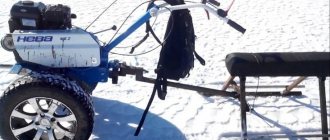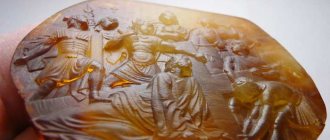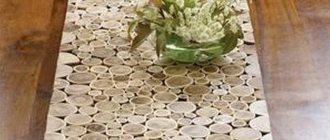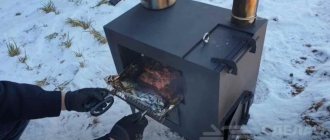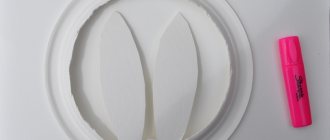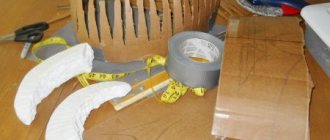Published:
13.06.2016
What’s good for Russians is bad for everyone else. Such a free interpretation of the well-known saying is justified by the way our roads look at a slight distance from federal highways and large cities. In addition, we really love to relax in nature, fish and hunt, and you can’t do all this from the side of the road. Plus dachas... Are there many reasons for a Russian to move off the asphalt? At the same time, you won’t get far in a passenger car. There are SUVs for a lot of money, there is special equipment, but all this is not suitable for the average person because the prices are too high.
That’s why unique tuning of people’s cars is flourishing in our country. The most popular in this regard is Niva. It itself has good off-road properties, and after some simple manipulations it completely turns into a Niva all-terrain vehicle. If the owner decides to make a car without regard for city roads, then the result will be a real off-road monster.
How tires operate at low pressure
The formation of low pressure in tires makes them somewhat flattened. Thus, upon contact with the surface, a large area is formed, which ensures the tightest possible adhesion to the surface, which makes the machine an all-terrain vehicle. The main thing is to maintain the rigidity of the entire structure and reduce the specific weight on the wheelbase. Otherwise, the car may simply fall apart when passing through difficult sections.
Please note that operating such machines requires some skill. “Niva” on low-pressure tires is not intended for driving at high speed, especially when cornering.
Main advantages
The first and also the main advantage of such modifications is the increased cross-country ability of the vehicle.
But, having “converted” the car in this way, you should understand that the speed will become significantly lower. Although for all-terrain vehicles this indicator is not the very first value.
Tuning a VAZ on low-pressure tires
All-terrain vehicles with such tires have increased grip on almost any type of surface. In addition, the following advantages of this type of low-pressure tires should be highlighted:
- the car does not disturb the outer layer of soil, so it can be used in agriculture and even protected areas;
- excellent grip on the road, which almost completely eliminates accidents.
But with all this, there is one not entirely rosy fact - the re-registration of the vehicle.
Since, according to its specifications, this is no longer a passenger car, but an all-terrain vehicle, it must be re-registered in order to avoid problems with the law.
Niva - all-terrain vehicle
Also, during the remodeling process, you need to pay attention to the car frame itself. You can choose articulated or rigid. It is impossible to say for sure which one is better. The main thing is that the frame ensures the rigidity of the entire structure.
Based on the above, we can say that making low-pressure tires on your own is not particularly difficult. You need to approach this matter responsibly and select the right materials for this.
Thus, you can get an almost universal car with a minimum of material costs. However, we should not forget about the legislative side of this process.
Author: Baranov Vitaly Petrovich
Education: secondary specialized. Specialty: car mechanic. Professional diagnostics, repair, maintenance of passenger cars of foreign production 2000-2015. Extensive experience working with Japanese and German cars.
Instructions for creating a tracked model
Schemes for creating all-terrain vehicles that are built independently are generally very similar. However, the creation of a tracked model has its own specifics. Its main aspects are listed in the following instructions.
- In order to create an all-terrain vehicle with a caterpillar undercarriage, you need to start by installing the body: it must have high strength and water resistance. To create a rigid base during its installation, steel pipes are used - they can withstand high stress.
- Then you need to install the tracks themselves. For this, sheet rubber is used, from which ring-type rubber is made. Aluminum blades are attached to its outer side. The limiters are mounted on the reverse side: it is important that their pitch width is no more than the wheel pitch width. Axles are pulled out through holes in the body, using special rubber couplings for protection. The tape is attached so that both the front and rear wheels are located between the stops.
- In order to support the belt, additional wheels are installed between the main wheels. It is worth noting that after completing all the work done, you need to install heavy-duty glass that will prevent dirt from getting inside the vehicle.
Is it possible to make caterpillars with your own hands?
If the cost of a ready-made set of tracks discourages you, you can consider the option of making it yourself, but you should know in advance about the labor intensity of such a process. You must be proficient in metalworking equipment at a master level and have design skills. Garage production may not even be considered, since you will have to use special machines and tools for turning hubs, assembling and installing sprockets, shafts and bearings.
There are three ways in which the Niva track you make will perform its functions - from a conveyor belt, from car tires or from belts. These will be the simplest structures, which, despite their functionality and maintainability, cannot be called full-fledged tracks.
This is interesting: Replacing the license plate light bulb
Conveyor belt tracks
To assemble the track kit, you can use a conveyor belt 8 - 10 mm thick and a bushing-roller chain. Be sure to sew the edges of the ribbon with fishing line to strengthen it and avoid fraying. Use a blanket stitch. The hinge can be used to connect the ends of the tape. Connection by stitching can also be used, but the reliability will be questionable. In general, this design inspires confidence in terms of reliability and can be easily repaired.
Also, tracks can be made from a conveyor belt using a rectangular profile pipe. To do this, you must first give the tracks the required shape using a pressing machine. You can use nuts and bolts to secure the tracks to the tape. We will look at this technology in more detail. You will need the following tools and materials:
- pressing machine;
- hammer and set of keys;
- hole puncher;
- drill, angle grinder and welding machine;
- fittings and profile pipe;
- screws, washers, nuts and bolts;
- conveyer belt.
The step-by-step technology is as follows:
- Taking into account the width of the track being made, use a grinder to cut the track blanks.
- Press the workpieces on the machine to give them the required shape, use waste oil to lubricate the ends.
- Weld fangs-limiters onto each track and additionally V-shaped fittings at the top.
- At the track installation site, check the correct dimensions.
- Use an industrial hole punch to create holes in the conveyor belt. You can make such a hole punch yourself - it will be a tube sharpened at the end with a side hole for removing rubber waste.
- Drill two holes in the tracks on each edge.
- At the final stage, you will be assembled the caterpillar.
Caterpillars made from car tires
If you decide to use car tires to make tracks, you should choose them with the appropriate tread pattern, which will replace the lugs. Tires from tractors or trucks will do. Carefully remove the tire beads using a well-sharpened shoe knife. Periodically wet the blade in soapy water to make cutting easier.
If you have the skills to use an electric jigsaw, you can use this tool in tandem with a fine-toothed file.
To achieve the required level of elasticity, several layers of the inner ring can be removed. Compared with the first option (conveyor belt + bush-roller chain), car tires are more reliable, since the contour of the ring in this case is closed and the ends do not need to be connected.
Belt tracks
Track kits made from belts also fall into the category of easy-to-manufacture designs. Grousers are used to assemble the track from V-shaped rubber belts. The connection is made using small bolts and rivets. The interval between the belts must correspond to the dimensions of the drive sprocket. Use rivets to secure the ends of the resulting fabric.
How to choose new tires
Large, low-pressure wheels are ideal for the swamp vehicle. They do not sink into soft soil, while maintaining the necessary adhesion to the soil.
Types of tires for swamp vehicles:
- Arched.
- Toroidal.
- Wide-profile.
The tires have the required pattern. They are distinguished by their long service life and high strength coefficient. Some models are equipped with systems that provide operational pumping. The driver has the ability to adjust tire pressure depending on the quality of the road.
Without cutting arches
If you install wheels with a diameter of 29 inches on a Chevrolet Niva, then there is no need to cut the arches. In rare cases, the corners on the bumper (front) are processed. A few years ago, special “Lapter” extensions were made for the pre-restyling Chevrolet Niva, but then their production was curtailed.
With the need for cutting
To install low-pressure wheels, a large amount of work must be carried out:
- lifting suspensions or body;
- cutting arches;
- removal outside the body.
It is necessary to cut the arches of the Niva in order to install elements with a diameter of 28-30 inches. This requires a special tool, as well as experience in performing such work.
The front arch is redesigned relatively simply, but with the aft block the situation is somewhat more complicated. The arch is formed from 2 elements (internal and external). After trimming, the 2 parts need to be brought together and bent correctly.
Advantages:
- The strength factor is high.
- Looks aesthetically attractive.
- The straightening and cutting of the arches is done together with the installation of the Lapter extensions.
The difficulty of the work lies in the fact that the strength and rigidity of the body material must remain practically unchanged.
For snow and swamp vehicle
The best tires for swamp vehicles have the following characteristics: VID 20, dimension 1300 x 530-330, can operate at pressures up to 0.5 atm. Sometimes they make tires for Niva with their own hands.
Karakat is also equipped using a similar algorithm. Used sources are taken from trucks, helicopters or airplanes; standard car tires are used.
Power unit and transmission for tractor from Niva
The basis of the future homemade product will be the engine removed from the old VAZ.
To do this it:
- We remove the engine from the car and place it on a subframe. We give it a low landing, so that the front axle is between the engine and the gearbox;
- Fix with ties;
- We calculate the gear ratio, which should not exceed 2 thousand rpm for operation in 2nd gear - the main one used for plowing;
- To divide the torque between the axles, we limit ourselves to the transfer case from the Niva. It is needed in order to: increase the tractor’s cross-country ability on country roads; the drive wheels were subjected to greater rolling; the tractor moved confidently and stably regardless of the mode and power.
- We also take the clutch and gearbox from Niva;
- We connect the crankshaft to the PTO, which is best purchased ready-made;
- We connect the gearbox secondary shaft hub to the gearbox, which will transfer torque forward. The revolutions to the rear half-frame will be supplied through the fracture joints and the driveshaft.
Wheelbase and steering wheel for a tractor from Niva
- For a homemade tractor, 12-14 inch wheels from an old car (Niva, Oka), which are equipped with tires with a rough tread pattern, are suitable;
- The steering column is taken from the VAZ and placed on a plate welded into the front half-frame. It is important to correctly determine the height of the steering wheel: its smooth movement should not be interfered with by the tractor driver’s knees;
- We change the worm gear, for which we make a gap in the bearing adjusting nut and in the oil tank cap;
- It is almost impossible to assemble a full-fledged hydraulic unit with your own hands. Therefore, it is easier to buy it or take it from an old tractor;
- We fit the hydraulic pump and lubricant reservoir next to the engine, making a hydraulic outlet in front and rear for multi-position installation of attachments;
- We install a power cylinder that will control the adapters.
brief information
People who are passionate about fishing, hunting, off-road driving, and workers in remote areas buy a Niva Lynx car. It is made on the basis of the Lada 4x4 and is a small-scale model of the PSA Bronto company.
The model is designed to make life comfortable for ordinary citizens and various enterprises operating in areas where asphalt roads can only be dreamed of. For quite a long time, fans of popular SUVs believed that the famous Niva would pave the way wherever its owner wanted. But as practice has shown, there are still shortcomings. Therefore, the main emphasis of this car is based on improving all-terrain properties.
By intelligently refining the suspension elements and some parts of the car body, the developers installed specialized wheels and extra-dimension off-road tires that lifted the car. In addition, the rear axle has been strengthened, so that its geometry is not destroyed in difficult driving conditions.
Beginning of work
As a basis for the manufacture of low-pressure tires, you can take rubber from large special vehicles. Material from agricultural, industrial or aviation transport is best suited. It is also possible to use tires from large trucks.
Before you start working on the wheel, you should thoroughly wash and dry the wheel. Next, the rubber gets rid of everything unnecessary - it needs to be made as light as possible, but without losing strength.
You can make rubber lighter in this way:
- remove the cores inside;
- cut off excess rubber on the sides and from the tread;
- dismantle part of the cord.
Making a low-pressure tire
Please note that the area from which the rubber was removed must be thoroughly cleaned with fine-caliber sandpaper.
After the rubber itself is ready, you should assemble the base for it - the disc. This should be done as follows:
- a regular disk is cut in half;
- the surface is carefully polished.
You can weld the disk yourself if you select the required size of pipes and weld them together correctly. The surface must be sanded very well so as not to damage the camera later.
At the final stage, the finished tire is stretched onto the disk and secured with a belt. If you don't have a belt, you can use a regular fire hose. Next, the finished wheel is checked and inflated. After that, it is suitable for installation on your car. As you can see, making such low-pressure tires with your own hands is not particularly difficult.
DIY tuning of Niva 2121 for off-road
Initially, the Niva 2121 was created as a universal all-terrain vehicle that feels comfortable off-road and in the city. Therefore, it is logical that off-road tuning of the Niva 2121 is especially popular.
This is due to its relative simplicity. To create, or rather, enhance the image of an SUV, you need to install on your car:
- Larger diameter wheels with tires designed for extreme off-road use. It should be recalled that low-profile tires are not relevant in this case. It is also necessary to take into account that installing large-diameter disks requires impressive torque figures. Ignoring this rule will lead to premature wear of the power unit
- Installing arch extensions on a Niva will solve several problems at once: get rid of splashes of dirt on the wings and doors, expand the possibilities in terms of choosing the diameter of the disks, and complement the tuning composition
- Power kit. It consists of a powerful kenguryatnik. It is easy to make it yourself from pipes. A structure is installed on the rear door, onto which the spare tire is attached. It will also perform a protection function. A winch must be installed. It will help off-road and give the car an aggressive, masculine look.
This is all that is needed to create a car designed for participation in sports competitions or outdoor activities. This external tuning of the Niva 2121 combines aesthetic and practical functions. Therefore, the efforts and resources invested in it will quickly pay off.
You can do an easy tuning of the Niva 2121 - install new wheels and tires and apply stylish airbrushing with a 3D effect. To carry out the last operation, it is necessary to attract specialists.
Timber truck made from “kopek”
This is one of the most unusual homemade designs I have seen. Here is a homemade timber truck with a two-axle all-wheel drive tractor and a single-axle trailer. The body is taken from a VAZ-2101, but now it does not have a hood or trunk. The driver sits directly above the front axle.
It must be said that this arrangement hardly provides good comfort inside, but it allows you to transport not only an armful of logs, but also several passengers in the cabin. The engine is apparently hidden under the body.
Important points before starting work
Before starting assembly, you should make drawings, sketches, calculate the loads, and determine the sequence of work.
There are many successful models created long ago; the easiest way is to borrow some functioning example of a swamp vehicle made on the basis of the Niva.
To work you will need tools and an equipped garage. It will be necessary to raise the bottom of the car, additionally weld assemblies from channels and pipes, install large-diameter wheels, remove the wings, placing mudguards in their place.
Manufacturers
To be fair, it is worth noting that they were developed in the USA, and only after that they were distributed throughout the world. Now several dozen, and maybe hundreds of companies around the world, including Russia, are doing this.
If we take imported options, then the most famous of all is the company – Mattracks, this is one of the founders of the production of such “skating rinks”. True, their prices are steep; for the price of a set you can buy a Russian car.
If we take domestic manufacturers, then here we can highlight Chelyabinsk, it is there that rollers for NIVU, UAZ, etc. are produced. The cost is several times lower than that of foreign analogues.
Don't panic
What we wrote above is by no means the ultimate truth. If you would like to simply “pump up” your Niva in order to drive on dirt roads without problems, then all these deep alterations do not concern you. At the same time, it is necessary to mention how Niva-based all-terrain vehicles are made without the hassle of replacing the gearbox: the original transmission is not so bad on moderately bad roads and its replacement is only necessary when, due to the replacement of the transfer case, both the gear ratios and the set of gears need to be replaced The gearbox will no longer be enough. Please note that the swamp vehicle also requires air cylinders in case of immersion in water, so that dirty water does not get into the engine. Homemade all-terrain vehicles based on the Niva usually do not have documents and are made for yourself, so you won’t be able to buy a fully “charged” SUV for the price of a regular car. They are assembled with manic attention to every detail, weighing the pros and cons, but nevertheless carefully. After all, you won’t be able to drive such a car both in the city and outside the city at the same time. And outside the city, we don’t have such road conditions everywhere that we really need an all-terrain vehicle. Theoretically, every car enthusiast can make such a car with his own hands, but not everyone needs it. Those who fall into this category will look for spare parts from army vehicles, from UAZs and Nivas, combine them, conduct tests, specifically going to places where no one else in their right mind would go on foot. And such a person is ready to make sacrifices. For example, the fuel consumption of such a car will be simply astronomical: as we have already said, the engine will mainly work under load, turning huge wheels through a non-original gearbox, transfer case and axles. It is clear that 10 liters per hundred will only be a dream. On the other hand, you are unlikely to entrust your Frankenstein to some car service center. You will have to repair it yourself or with the same friends who are passionate about building all-terrain vehicles.
Let's get started, I guess
The first purchase for a person who is going off-road is a winch. This is not even discussed. An all-terrain vehicle based on the Niva is usually made from a three-door model, since its body is lighter and has proven itself in terms of bending and fracture strength. The engine is also left stock. It has good low-end thrust (until you start comparing it to diesel engines, of course). And then the revision begins. A Niva-based swamp vehicle must be equipped with an appropriate gearbox. As a rule, because of the 5 stages, the box is taken from a VAZ “tens”, and the transfer case is taken from a UAZ. Before you make a swamp vehicle from Niva, think about the wheels. They should be large to provide the largest possible contact patch with the surface. This way the car won't get stuck in the mud. But such wheels require appropriate axles and a frame. As a rule, if possible, they get bridges from a military UAZ. They are equipped with final drives; but you can make the frame yourself. To make it light, the craftsmen who make all-terrain vehicles from Niva use aluminum. So, although the tires should be large and wide, they should not be too heavy, otherwise the engine, with all its throttle response, will not be enough. Therefore, the people's genius came up with the idea of taking wheels from KrAZ and cutting off the excess tread, which is not needed on a much lighter all-terrain vehicle based on the Niva.
It will be useful to install power steering on your car. Since the wheels will be large and the road will not be as good, the effort on the steering wheel will become excessive and you will quickly become exhausted turning such a heavy steering wheel. But what's really critical is the cooling system. The standard system is not bad, but it is absolutely not enough. Therefore, it makes sense to install an additional radiator and cooling fan under the hood of the Niva all-terrain vehicle. It will improve heat removal from the engine, which constantly operates at low speeds and therefore heats up beyond measure.
New everywhere based on LADA x
Self-locking cross-axle differentials installed on the axles prevented wheel slipping when driving on rough off-road conditions.
The gear ratio of the main drive axle gearboxes has been rebuilt to 4.1, which gives the vehicle off-road auxiliary potential.
For off-road use, tires with increased load capacity 235/75 R15 are installed. This technical solution provided the car with additional clearance of 12 mm. The wide tread provided better ride smoothness and traction with the road surface.
Chassis:
- The ground clearance of the front suspension has been increased by 25 mm with the help of larger shock absorbers.
- The rear clearance has been increased by 50 mm by installing shock absorbers and an axle with a U-shaped box.
- The rear suspension has been strengthened and the support has been raised by 40 mm.
- An adjustable panhard rod is installed.
- Shock loads are reduced with reinforced springs.
- Helical self-locking differentials with a preload of 4.5 kg are installed in the front and rear axles.
- The breathers have been removed.
- The edges were trimmed to accommodate the large wheels in the arches.
- Rubber extensions are attached to protect the body from rising splashes.
- The mirrors are installed with an increased rear viewing area.
Body:
Individual assembly of the car with the installation of any additional equipment is possible.
| Niva Bronto Lynx 1 | 3-doors, 1.7l engine, all-terrain power steering, increased. travel in front and rear suspension, differential self-locking, tires 235.75R15 with lugs, modified wheel arches, air conditioning | 670000 |
| Niva Bronto Lynx 2 | 5-doors, 1.7l engine, all-terrain power steering, increased. travel in front and rear suspension, differential self-locking, tires 235.75R15 with lugs, modified wheel arches, air conditioning | In stock |
| Sales department phone number: 8(8482)615-675 8(9278)915-675 |
| Additional equipment | |
| Snorkel | 12000 |
| Air conditioner | 33000 |
| Expeditionary roof rack | from 16000 |
| Towbar | 5000 |
| Reinforced bumpers | 11000 |
| Winch | 9000 |
| Railings | 5500 |
| Threshold protection | from 3500 |
| Anatomical heated chairs | 7000 |
| Tinted glass | 3000 |
| Anticorrosive with liquid lockers | 4500 |
| Music | from 7000 |
| Signaling | from 6500 |
| Noise and vibration insulation | from 15000 |
| Camouflage coloring | 68000 |
Making a real SUV out of Niva (from our own experience)
Denis [den10031996]
21.12.2017,
The Niva is a unique domestic car, as well as the first family all-wheel drive SUV. This model in its factory condition is capable of overcoming difficult sections of roads, but does not always successfully cope with its responsibilities. This is due to the following factors:
- Insufficient tire width and tread depth, as well as wheel size;
- Low clearance for swamps and typical areas;
- Low engine power (it is noteworthy that with a factory power of 76 hp, the power delivered to the wheels does not exceed 50 “horses”);
- Lack of reliable transmission mounting;
- Heavy body for such an engine.
In order to make a real all-terrain vehicle out of the Niva, the following components and assemblies will be modernized:
- engine;
- gearbox with axles and transfer case;
- suspension lift;
- body lightening.
Engine
The basis will be a 1.6 liter carburetor engine. In order for you to end up with a powerful engine to overcome difficult roads, you will need a complete overhaul. First of all, the cylinder block needs to be bored to a size of 82 mm. This will allow you to install model 21213 pistons, or slightly lighter 21083 pistons. Lightweight connecting rods (each 125g) will be mounted in tandem with the new pistons. In order to obtain a volume of 1.8 liters, we purchase a crankshaft with a piston offset of 84 mm.
As for the lubrication system, the installation of a high-performance oil pump is required. This completes the construction of the bottom of the engine. The cost of the above kit will be approximately $500.
For a volume of 1.8 liters, it will be necessary to enlarge the cylinder head channels in order to improve cylinder purging. Following this, we install lightweight valves, as well as a wide-phase camshaft, with an overlap of 256-289 degrees, so that the torque is maximum from 2000 to 7500 rpm. For reliable timing operation, we purchase a reinforced set of sprockets and timing chains. The cost of work and spare parts for the cylinder head will average $250.
To ensure high-quality and timely ignition, we install BSZ ($35).
In order to feed the new engine, you will need to buy a Solex carburetor for Moskvich 2141, with a volume of 1.8-2.0 liters, or a Solex Sport ($95).
The exhaust system must be direct-flow, the kit costs 120 cu.
To overcome deep bodies of water, you will need to move the generator at the level of the cylinder head, as well as install a snorkel. A new powerful generator with an installation kit will cost 100 euros, and a snorkel 50 euros.
Now we have a ready engine for a real SUV, the approximate power of which is 120 hp, and the cost of building an engine from scratch is $1000.
Transmission
Regarding the gearbox: it will be enough to rebuild it again. The clutch can be installed from a Chevrolet Niva, since the diameter of the clutch disc is 215 mm, which allows you to maintain high power. Repairing the gearbox and a new clutch will cost 200 euros.
We install cardan shafts on CV joints, after which we get rid of problems with crosspieces (150е).
The transfer case also undergoes a major overhaul, and a subframe is purchased for it, which will securely secure the transmission element, extending its life (150 cu).
We install screw differential locks on the front and rear axles, which are highly reliable. The cost of two blockings is 400 cu.
The axle shafts, after installing large wheels, must be reinforced and larger in diameter. Such a kit will cost 300.
In total, the modernization of the transmission will cost 1200 cu.
Suspension
To increase the ground clearance by 50 mm, you will need a lift kit, which costs 150 euros. In addition, you will need adjustable reaction rods (60е), gas-oil shock absorbers and rigid springs (120е). We buy a reinforced bridge stocking, since the load on it will increase significantly. We also purchase anti-roll bars with a large diameter.
We install wheels of increased diameter with mud tires. To install the wheels, you will need to trim the arches and install spacers. A set of wheels will be released in the 800.
In total, the chassis came out to us at 1200.
Body and its relief
The Niva body weighs quite a lot, so we will reduce the weight using fiberglass body parts; this will be the trunk lid, hood and fenders. This kit will cost 200. The bumpers should be replaced with power ones, with the ability to install a winch. The initial cost of power bumpers with a guardrail and side bars is 400 euros.
The optics should be replenished with at least two yellow fog lights, as well as an LED chandelier on the roof (150e). In order to place a spare tire, a shovel, a canister and other necessary things for successful off-road trips, we install a special roof rack (150uye).
Note that after installing large-diameter wheels, they will rub against the arches, so the arches will need to be trimmed, and to give an aesthetic appearance, install plastic arch extensions.
On average, modernization and equipment of the body cost 950.
As for the interior, it is recommended to install additional instruments that provide true information about engine temperature, oil pressure and on-board voltage. It is recommended to change the seats so that during sharp turns and when rolling you can sit comfortably and comfortably.
Based on the list described above, we can reveal the following: for 4,500-5,000 dollars we get an SUV, built with our own hands, which will overcome obstacles that are beyond the capabilities of many modern jeeps. Of course, for this amount you can find an old SUV with similar characteristics, but maintaining and repairing such a “vehicle” will be much more expensive than maintaining a VAZ Niva. Also, a big advantage of the Niva is its availability for tuning and modernization, and the cost of improved spare parts is an order of magnitude lower than that of foreign competitors.
Tags
All-terrain vehicle Niva All-terrain vehicle Characteristics of an all-terrain vehicle make an all-terrain vehicle from Characteristics of an all-terrain vehicle on Dobrynya All-terrain vehicle Dobrynya All-terrain vehicle dune All-terrain vehicle fracture with homemade all-terrain vehicles driving all-terrain vehicles in Niva all-terrain vehicle on Design of Niva Construction of Niva with your own hands with your own hands. with your own hands to make with your own hands with your own hands with your own hands with your own hands. remaking your car non-standard Russian car remaking your car with your own with your own hands, a car with your own hands, with your own hands, with your own hands, with your own hands, with your own hands, with your own hands, with your own hands, with your own hands, in your all-terrain vehicles. to your list
homemadeframesphototuningreadmotoblockothers
